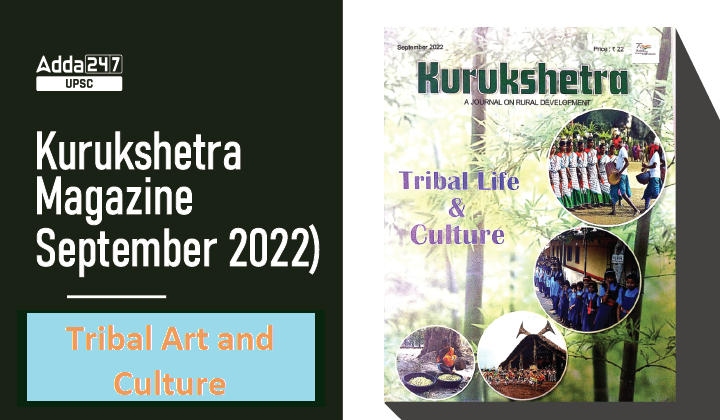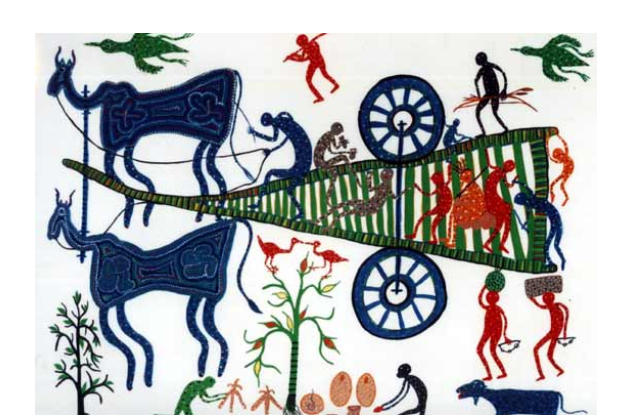Table of Contents
Kurukshetra is a Monthly Magazine which is issued by the Publications Division of the GOI.
Kurukshetra Magazine is one of the most important and indispensable source for UPSC Civil Services Exam Preparation. Keeping this in mind, here, we come with ”Analysis Of Kurukshetra Magazine” on daily basis, which covers the monthly Kurukshetra Magazine in easy and smooth pointed form, keeping in mind the demand of UPSC aspirants.
Introduction
- Tribal art generally reflects the creative energy found in rural areas that acts as an undercurrent to the craftsmanship of the tribal people.
- Every tribe maintains its very own culture, dialect, and economic activities within its own ecological habitat.
- Tribal art ranges through a wide range of art forms, such as wall paintings, tribal dances, tribal music, and so on.
Are Tribals Aliens?
- The history of India’s Adivasis dates back to the pre-Aryan era. For ages they reigned over the Subcontinent’s hilly terrains.
- But over the centuries those with access to the written word (apart from other things) gained prominence over those whose traditions were rooted in the oral culture.
- During the colonial period, Adivasis were given the new designation of tribal, and in post independent India, they are known as the scheduled tribes.
Evolution of Tribal Culture
- The evidence of the earliest tribal culture comes from India’s Upper Palaeolithic period.
- Twelve years before the discovery of Altamira in Spain – the location of the oldest rock paintings in the world – the first known discovery of rock paintings was made in India in 1867-1868.
- Bhimbetka, Jogimara in MadhyaPradesh, Lakhudiyar in Uttarakhand, Tekkalakota in Karnataka and Kupgallu in Telangana, among other places are examples of early rock painting sites.
Characteristics of Early Paintings
- Paintings are linear representations, in green and dark red, of huge animal figures, such as multi-legged lizard and foxes beside stick-like human figures.
- Mostly they are filled with geometric patterns.
- The subjects of paintings evolved with time and creatures like bulls, elephants, sambars, sheeps,horses, styled humans started to appear.
- The Mesolithic period has the greatest concentration of Paintings, the majority of which features hunting scenes. A common theme is presented by community dances.
- The Indus Valley Civilisation which coincided with the copper and bronze age placed great emphasis on art and culture.
Examples of Tribals Paintings
Bhils
- India has numerous tribal painting styles each with its own sets of colours and themes.
- Bhils, largest tribal group in India places high value on art. Their paintings, rich textures,steeped in rituals, symbolism and traditions, connect them to nature.
- Bhil Paintings are characterised by large, un-life-like shapes of everyday characters that are filled in with earthy, yet bold colours before being covered with an overlay of uniform dots in a diverse array of colours and patterns that stand out against the background.
- The Udaipur Bhils decorate the walls of their houses and temples with images of the gods, flowers, animals and birds. They call these wall paintings mandno. Bhil mandno are stylized line drawings.
Warli Painting
Warli painting is a traditional Maharashtra art form that traces its origins back to the 10th century A.D.
Saura
- The ‘Saura’ is a tribe from the jungles of Odisha, Jharkhand, Madhya Pradesh, Andhra Pradesh, and Maharashtra.
- Nature’s splendour is celebrated in Saura art.
- The ‘Tree of Life’, which has human and animal inhabitants on its branches and symbolises the harmonious coexistence of humans and animals, is the basis for the majority of paintings.
- Idital, the primary deity of the Sauras, is honoured by the wall paintings created by the Saura people, known as ‘talons or Ikons. The ritualistic significance of these paintings is derived from their use of tribal folklore.
Digna
- The Gond paint the inner and outer walls of their house with Digna which is the traditional geometric pattern, while bhittichitra is a composition of likenesses of animals, leaves and flowers.
- Vegetable and mineral dyes are used for colour –flowers, leaves, clay, stones, rice, turmeric. Brush are handmade made from a neem or babul twig and a rag.
Tribal Crafts
- Indian tribal crafts are typically ritualistic, drawing a clear distinction between the artist and the art lover.
- Each group has its own festivals, myths, taboos, rituals, music, dance and music which have a profound influence on the group’s art and crafts.
Dhokra
- The eastern Indian states of West Bengal, Odisha, Jharkhand, and Chhattisgarh are home to the ancient folk-art tradition known as ‘Dhokra’.
- Dhokra craft objects are made using lost wax-casting technique.
- Each tribal region creates something distinct in design and form that carries the impression of its own mystic ideology, the life and attributes, as well as belief and reflections of its people.
Tribal Dance Forms
Kalbelia
- The Kalbelia dance is performed as a celebration and an integral part of Kalbelia culture.
- Their dances and songs are a matter of pride and a marker of identity for the Kalbelias, as they represent the creative adaptation of this community of snake charmers to changing socio-economic conditions and their own role in rural Rajasthani society.
- Kalbelia songs are based on stories taken from folklore and mythology and special dances are performed during Holi.
- In 2010, the Kalbelia folk songs and dances of Rajasthan were declared a part of its Intangible Heritage List by UNESCO.
Dumhal Dance
- It is performed in Jammu and Kashmir by the Watal tribe.
- Only the female folk of the wattal are privileged to perform this dance, on specific occasions and at set locations.
- The dancers sing in the chorus. Drums are used to assist the music.
- The performers move in a ritual manner and dig a banner into the ground on set occasions.
- Usually, the dance begins with men dancing around this banner.
Hojagiri Dance
- Performed in the state of Tripura by the Reang people.
- It is performed by women and young girls, about 4 to 6 members in a team, singing, balancing on an earthen pitcher and managing other props such as a bottle on the head and earthen lamp on the hand.
Bhavada Tribal Dance
By Kokna tribesmen from Dadra and Nagar Haveli.
Gussadi
By Raj Gonds in Telangana.
Saila, Rina and Dadariya
- The Gonds express themselves through different forms of dance like the Saila, Rina and Dadariya, which are performed during festivals.
- The Saila was once performed with swords. Now these have been replaced by sticks. The Dadariya is sung when the groom arrives and again when she leaves with her groom. But it is the Karma that can be performed any time of the year.
- When a guest arrives, the family gathers and they all do the Karma dance together. The themes of the Karma songs are about life.
Tribal Music
- Indian tribal music features lyrical chanting, traditional sounds and modern musical variations.
- Learning process of tribal music is inherited through generations, given the passage of time and changing tastes, variations in the current form are to be expected.
- Songs in tribal societies are mostly functional with added sanctity of a ceremonial rite.
Gudna
- Another form of creative expression is the gudna or tattoo.
- Images of the sun, moon, birds and various elements are traced on body parts in the belief that the wearer carries the gudna to the next world.




 TSPSC Group 1 Question Paper 2024, Downl...
TSPSC Group 1 Question Paper 2024, Downl...
 TSPSC Group 1 Answer key 2024 Out, Downl...
TSPSC Group 1 Answer key 2024 Out, Downl...
 UPSC Prelims 2024 Question Paper, Downlo...
UPSC Prelims 2024 Question Paper, Downlo...
